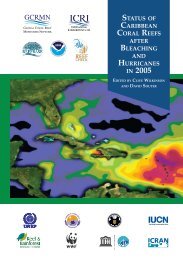Coral Health and Disease in the Pacific: Vision for Action
Coral Health and Disease in the Pacific: Vision for Action
Coral Health and Disease in the Pacific: Vision for Action
You also want an ePaper? Increase the reach of your titles
YUMPU automatically turns print PDFs into web optimized ePapers that Google loves.
Where are <strong>the</strong>se pathogens com<strong>in</strong>g from?External sources of pathogens that have been proposed <strong>in</strong>clude terrestrial runoff(Aspergillus), sewage (Serratia marcescens), <strong>and</strong> African dust events (Aspergillus).Pathogens may also already be present <strong>in</strong> <strong>the</strong> mar<strong>in</strong>e environment. Reservoirs of P.corallyticum (along with o<strong>the</strong>r cyanobacteria) occurred as biofilms on <strong>the</strong> surface ofsediment patches present <strong>in</strong> depressions on healthy M. annularis, M. cavernosa <strong>and</strong> C.natans colonies (Richardson, 1996). These may be dispersed via movement of watermasses, especially dur<strong>in</strong>g storms (Bruckner <strong>and</strong> Bruckner, 1997), <strong>and</strong> transmitted throughvarious vectors like damselfish, parrotfish, fireworms <strong>and</strong> coral-eat<strong>in</strong>g snails (Williams<strong>and</strong> Miller, 2005; Aeby <strong>and</strong> Santavy, 2006).Bacteria also occur on corals <strong>in</strong> a non-<strong>in</strong>fectious state. <strong>Coral</strong> mucus is a richprote<strong>in</strong>-carbohydrate complex that harbors a diverse community of bacteria <strong>and</strong> o<strong>the</strong>rmicrobiota, <strong>and</strong> <strong>the</strong>se communities are known to be dist<strong>in</strong>ct from <strong>the</strong> surround<strong>in</strong>g water(Rohwer <strong>and</strong> Kelley, 2004). Bacterial diversity varies between healthy corals, healthyparts of diseased corals, <strong>and</strong> diseased tissue (Rohwer et al., 2002; Pantos et al., 2003).Environmental changes can affect <strong>the</strong> physiological equilibrium between bacteriaassociated with <strong>the</strong> corals <strong>and</strong> <strong>the</strong>ir hosts, or stimulate <strong>the</strong> growth of o<strong>the</strong>r bacteria(Pantos et al., 2003). The coral-microbe relationship can be disrupted by nutrient <strong>and</strong>organic carbon load<strong>in</strong>g by overstimulat<strong>in</strong>g <strong>the</strong> growth of <strong>the</strong>se microbes, which mayresult <strong>in</strong> coral mortality (Kuntz et al., 2005). Under stressful conditions one or more of<strong>the</strong>se microbes may become virulent or affect <strong>the</strong> resistance of <strong>the</strong> host, <strong>and</strong> subsequentlytrigger onset of an <strong>in</strong>fectious disease.Are disease outbreaks associated with chang<strong>in</strong>g environmental conditions?<strong>Disease</strong>s may be <strong>in</strong>fectious (produced by parasites <strong>and</strong> pathogens) or non<strong>in</strong>fectious(genetic mutations, produced by environmental factors). The frequency <strong>and</strong>severity of <strong>in</strong>fectious diseases may affected by chang<strong>in</strong>g environmental conditions(elevated SST, decl<strong>in</strong><strong>in</strong>g water quality), human <strong>in</strong>duced alterations of <strong>the</strong> mar<strong>in</strong>eenvironment (e.g., <strong>in</strong>put of l<strong>and</strong>-based pollutants; dredg<strong>in</strong>g, coastal development), <strong>and</strong>hurricanes <strong>and</strong> o<strong>the</strong>r natural disturbances. Increased temperatures may causephysiological stress <strong>and</strong>/or trigger <strong>the</strong> development of pathogenic agents that o<strong>the</strong>rwisewould rema<strong>in</strong> non virulent.Increased abundance <strong>and</strong> virulence of at least five diseases (BBD, WPX, DSD,ASP <strong>and</strong> YBD) has been associated with elevated seawater temperatures, with decl<strong>in</strong>es <strong>in</strong><strong>the</strong>se conditions reported dur<strong>in</strong>g w<strong>in</strong>ter months (Kuta <strong>and</strong> Richardson, 2002, Alker et al.,2001; Patterson et al., 2002, Gil-Agudelo <strong>and</strong> Garzón-Ferreira, 1999 <strong>and</strong> Weil, 2004).<strong>Disease</strong> outbreaks may also be more severe dur<strong>in</strong>g or immediately follow<strong>in</strong>g bleach<strong>in</strong>gevents due to a lower resistance of host corals. Widespread <strong>and</strong> severe outbreaks of WP-II were observed <strong>in</strong> Puerto Rico, USVI <strong>and</strong> <strong>the</strong> eastern Caribbean follow<strong>in</strong>g <strong>the</strong> 2005Caribbean bleach<strong>in</strong>g events (J. Miller, coral list post<strong>in</strong>g; Weil, 2006). O<strong>the</strong>r naturalfactors, such as habitat characteristics, composition, cover <strong>and</strong> abundance of susceptiblecorals, <strong>the</strong> amount of macroalgae, <strong>and</strong> presence/absence of certa<strong>in</strong> key <strong>in</strong>dicator speciessuch as Diadema may also <strong>in</strong>fluence <strong>the</strong> occurrence <strong>and</strong> severity of coral diseases.Patterns of disease distribution obta<strong>in</strong>ed from <strong>the</strong> Global <strong>Coral</strong> <strong>Disease</strong> Database haveshown that 97% of <strong>the</strong> areas affected by disease <strong>in</strong> <strong>the</strong> Caribbean prior to 2000 correlate147
















